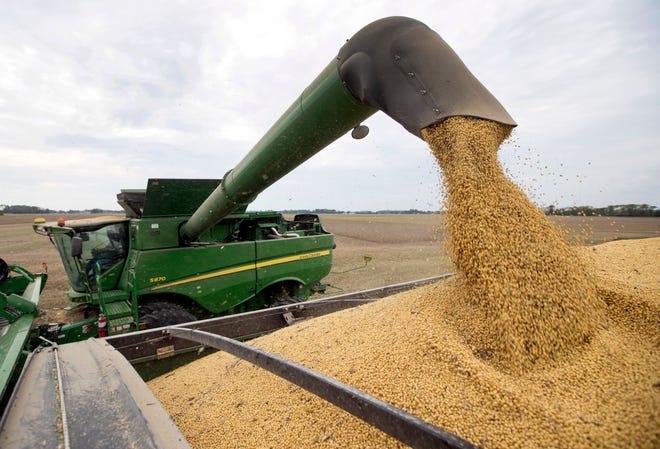Despite drought in southern WI, crop researchers say average yields expected

The 2021 growing season was one of the driest years in recent decades for southern Wisconsin.
But some crop researchers in the state say genetic developments have helped keep crop yields from suffering the way they have during previous droughts.
Many southern Wisconsin counties had drought conditions similar to 2012 and 2005, according to meteorologist Jaclyn Anderson with the National Weather Service in Milwaukee.
National Weather Service data shows the southeastern region continues to be nearly 10 inches below normal precipitation levels for the year. Anderson said this deficit has continued despite getting more persistent storms this fall. She said heavy rainfall events in August did little to make up the prolonged deficit because so much of the precipitation ends up running off the land instead of being absorbed in the soil.
Joe Lauer, agronomy professor at the University of Wisconsin-Madison, reviewed historical weather data at the UW Research Station in Arlington to see how dry 2021 was. The statistics date back to 1963.
He found this summer was similar to some of the driest years the station had on record, including 1988 when the station saw some of its worst corn yields.
"In the southern two tiers of counties in Wisconsin, we had some pretty dramatic drought conditions that farmers were experiencing. And it really didn't let up until probably the end of September," Lauer said. "We were dry most of that time. But having said that, we seemed to get a little bit of rain ... that allowed the crop to keep going."
Lauer said those timely rains are part of why this year’s corn yields were mostly unaffected.
The November crop production report from the U.S. Department of Agriculture's National Ag Statistics Service forecast the state's average corn yield would be 172 bushels per acre this year. That's one bushel less than 2020's average.
Crop experts have long believed that corn fields need at least an inch of rain per week between July and September to support crop development.
"This year, we just didn't get that inch a week," Lauer said. "We did have three weeks where we did get that inch, but that's only three out of 14 weeks that we were able to get that. But we seemed to get enough."
Lauer thinks new traits bred into modern day corn hybrids are helping crops get by with less water.
He said researchers bred for a trait to stop a pest called the European Corn borer, which creates tunnels in the stalks of corn plants that disrupt the flow of water from roots to leaves. And that has helped corn plants not have to work as hard to circulate moisture.
"That water molecule can get to where it needs to be in the plant and cool (the plant) down and make it a lot more efficient," Lauer said. "So I think that's one of the things that help these modern corn hybrids is just the efficiency of being able to get water within the plant where it's needed to keep it cool and to keep it growing and photosynthesizing and ultimately producing grain yield."
Chuck Steiner is director of Pioneer Farm, UW-Platteville's research station. He said the farm was in moderate drought for most of the season but received timely rains throughout the summer that helped keep their corn and alfalfa crops from feeling the heat stress. But he also agrees that modern hybrids have made a huge difference in the crop's ability to withstand less precipitation.
"There are ones that have either genes related to drought tolerance or drought resistance and the hybrids we produce now, I think, can withstand longer periods of drought without having a significantly negative impact on yield," Steiner said.
He said the farm saw significant crop losses during the last drought in 2012, forcing the farm to buy feed for the station's livestock programs.
"We ended up having to purchase a large amount of inputs and obviously that's expensive," Steiner said. "Having the ability to withstand some of the drought and still have high yields this year, especially when all of our crop production here at the farm is going to our livestock units, it's one piece of the puzzle that's helped us manage better and ensure that we’ll still be able to meet our livestock feed needs throughout the year."
Steiner said the dry weather throughout the season also allowed them to plant and harvest earlier, with crops drying out in the fields much more quickly in the warm weather.
Lauer said this summer's discovery about crop resilience is helpful for researchers and farmers as they think about the possibility of more growing seasons with weather extremes caused by climate change.
Lauer points out this year’s drought came not long after the state saw excessively wet weather in 2019 and 2018.
"There are some big extremes going on, but farmers so far have been able to successfully adapt to many of these extremes," Lauer said. "I think with modern plant breeding techniques, we’re able to stay ahead of the game now. How long we can do that is anybody’s guess."
This article republished with permission from Wisconsin Public Radio